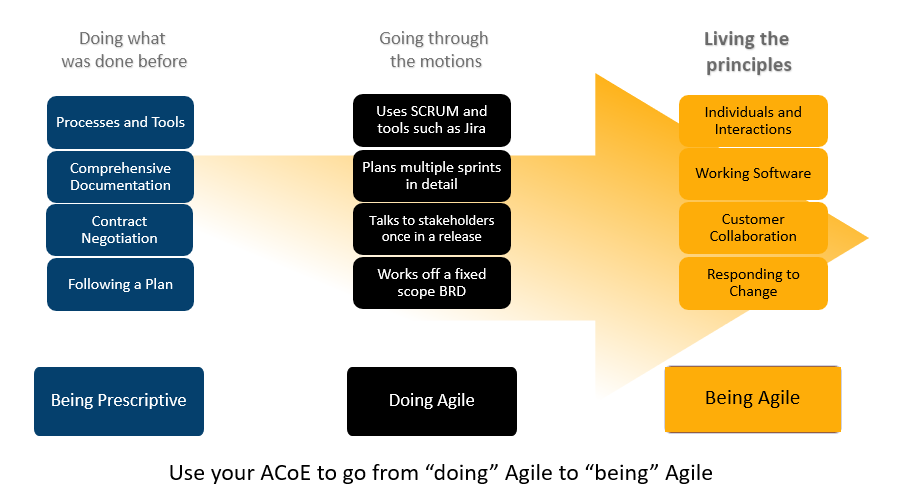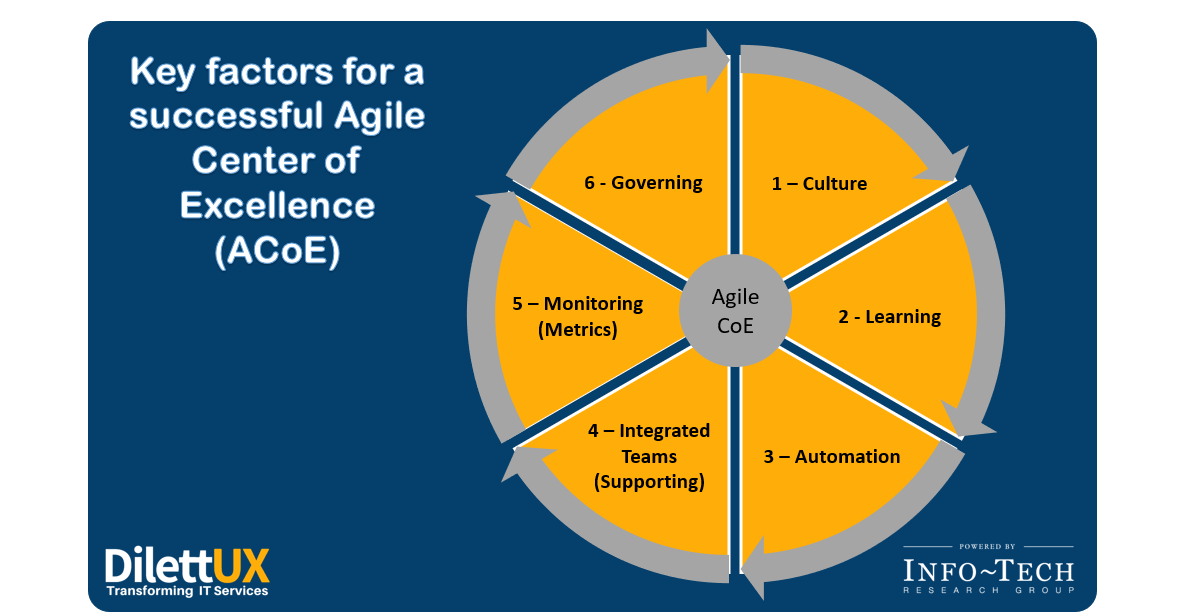Introduction
Creating an Agile Center of Excellence (ACoE) is a popular way to try to impose structure and improve performance. However, simply establishing an ACoE does not guarantee you will be successful with Agile Transformation. Organizational constraints, culture clash, and lack of continuous top-down support are hampering your Agile growth and maturity. Attempts to create consistency across Agile teams and processes fail to account for the expectations of users and stakeholders, leaving them detached from projects and creating resistance. Inconsistent processes and practices used across Agile teams is frequently cited as a challenge to adopting and scaling Agile within organizations.
When setting up an ACoE you must define ACoE services based on identified stakeholder needs, staff the ACoE with respected, “hands on” people, who deliver identifiable value to your Agile teams and continuously evolve ACoE service offerings to maximize stakeholder satisfaction and value delivered.
Spreading best practices with an ACoE will help you to:
- Align your Agile support structure with business objectives and the functional expectations of its users.
- Standardize the ways in which Agile teams develop and learn to create consistency in purpose and execution.
- Track and communicate successes to ensure the long-term viability of an Agile Center of Excellence (ACoE).
What is an Agile Center of Excellence?
An ACoE amplifies good practices that have been successfully employed within your organization, effectively allowing you to extend the benefits obtained from your Agile pilot(s) to a wider audience. From the viewpoint of the business, members of the ACoE provide expertise and insights to the entire organization in order to facilitate Agile transformation and ensure standard application of Agile good practices. From the viewpoint of your Agile teams, it provides a community of individuals that share experiences and lessons learned, propagate new ideas, and raise questions or concerns so that delivering business value is always top of mind.
An ACoE provides the following:
- A mechanism to gather thought leadership to maximize the accessibility and reach of your Agile investment.
- A mechanism to share innovations and ideas to facilitate knowledge transfer and ensure broadly applicable innovations do not go to waste.
- Strategic alignment to ensure that Agile practices are driving value towards business objectives.
- Purposeful good practices to ensure that the service offerings provided align with expectations of both your Agile practitioners and stakeholders.
Challenges to scaling Agile
These are the main challenges organizations have when scaling Agile:
- Organizational culture at odds with Agile values: The ACoE identifies and measures the value of Agile to build support from senior business leaders for shifting the organizational culture and achieving tangible business benefits.
- General organizational resistance to change: Resistance comes from a lack of trust. Optimized value delivery from DilettUX’s Agile adoption model will build the necessary social capital to drive cultural change.
- Inadequate management support and sponsorship: Establishing an ACoE will require senior management support and sponsorship. Its formation sends a strong signal to the organizational leadership that Agile is here to stay.
- Lack of skills/experience with Agile methods: The ACoE provides a vehicle to absorb external training into an internal development program so that Agile capabilities can be grown organically within the organization.
- Inconsistent processes and practices across teams: The ACoE provides support to individual Agile teams and will guide them to adopt consistent processes and practices which have a proven track record in the organization.
- Insufficient training and education: The ACoE will assist teams with obtaining the Agile skills training they need to be effective in the organization, and support a culture of continuous learning.
Overcome your Agile scaling challenges with a business aligned ACoE
An ACoE drives consistency and transparency without sacrificing the ability to innovate. It can build on the success of your Agile pilot(s) by encouraging practices known to work in your organization.
Shift Culture: Instill Agile thinking and behavior into the organization. The ACoE must encourage innovation and be an effective agent for change.
Facilitate Learning Events: Avoid the risk of innovation and subject-matter expertise being lost or siloed by facilitating knowledge transfer and fostering a continuous learning environment.
Support Agile Teams: Provide services designed to inject evolving good practices into workflows and remove impediments or roadblocks from your Agile team’s ability to deliver value.
Maintain Business Alignment: Maintain alignment with corporate objectives without impeding business agility in the long term. The ACoE functions as an interface layer so that changing expectations can be adapted without negatively impacting Agile teams.
Govern Improvements: Set baselines, monitor metrics, and run retrospectives to help govern process improvements and ensure that Agile teams are delivering expected benefits.

To be successful with your ACoE, do the following…
When setting up your ACoE, optimize its impact on the organization by doing the following actions:
- Align your ACoE with your organization’s strategy: Business justification to continue to fund a Center of Excellence can be a challenge, especially with traditional thinking and rigid stakeholders. Hit the ground running and show value to your key influencers through business alignment and metrics that will ensure that the ACoE is worth continuous investment. The pace of change in customer expectations, competitive landscapes, and business strategy is continuously increasing. It is critical to develop a method to facilitate ongoing alignment to shifting business and development expectations seamlessly and ensure that your Agile teams are able to deliver expected business value.
- Define ACoE services based on stakeholder needs. Be sure to broadly survey your stakeholders and identify the ACoE functions and services which will best meet their needs. ACoE services must clearly deliver business value to the organization and the Agile teams it supports.
- Staff the ACoE strategically. Select ACoE team members who have real world, hands-on delivery experience, and are well respected by the Agile teams they will serve. Where possible, select internal thought leaders in your organization who have the credibility needed to effect positive change.
- Continuously improve ACoE services based on metrics and feedback. The value your ACoE brings to the organization must be clear and measurable, and do not assume that your functions and services will remain static. You must regularly monitor both your metrics and feedback from your Agile teams, and adjust ACoE behavior to improve/maximize these over time.
Conclusions
Simply establishing a Center of Excellence for any discipline does not guarantee its success:
The 2019 State of DevOps Report found that organizations which had established DevOps CoEs underperformed compared to organizations which adopted other approaches for driving DevOps transformation.
Still, Agile Centers of Excellence can and do successfully drive Agile adoption in organizations. So what sets the successful examples apart from the others? Here’s what some have to say:
“The ACoE must be staffed with qualified people with delivery experience! … [It is] effectively a consulting practice, that can evolve and continuously improve its services … These services are collectively about ‘enablement’ as an output, more than pure training … and above all, the ability to empirically measure the progress” – Paul Blaney, TD Bank.
“When leaders haven’t themselves understood and adopted Agile approaches, they may try to scale up Agile the way they have attacked other change initiatives: through top-down plans and directives. The track record is better when they behave like an Agile team. That means viewing various parts of the organization as their customers.” – HBR, “Agile at Scale”.
“The best CoEs are formed from thought leaders and change agents within the CoE domain. They are the process and team innovators who will influence your CoE roadmap and success. Select individuals who feel passionate about Agile.” – Hans Eckman, InfoTech.
“the Agile CoE… is truly meant to be measured by the success of all the other groups, not their own…[it] is meant to be serving the teams and helping them improve, not by telling them what to do, but rather by listening, understanding and helping them adapt.” – Bart Gerardi, PMI.
“The CoE must also avoid becoming static, as it’s crucial the team can adjust as quickly as business and customer needs change, and evolve the technology as necessary to remain competitive.” – Forbes, “RPA CoE (what you need to know)”.
References:
Centers of Excellence (CoEs): © 2020 Project Management Institute, Inc
Info-Tech Research Group. Spread best practices with an Agile Center of Excelence, 2019 – Alex Ciraco, Research Director, Applications Practice.
As a certified Info-Tech partner, DilettUX can help you implement an Agile Center of Excellence that truly generates the expected value for your company. Schedule a meeting with us or contact us to better understand your need!


